All the other towns have pretty much assimilated into Dallas without leaving any trace of their former selves, and that makes the story of La Reunion all the more fascinating to me. Settled in 1854 and officially founded the next year to serve as a communal society operating on the socio-economic principles espoused by French philosopher Francois Marie Charles Fourier, the town sat on the Trinity River, three miles west of what used to be the village of Dallas. 200 immigrants from France, Belgium, and Switzerland got the project started, and while some of the colonists moved on, there were enough new arrivals to keep La Reunion operating for approximately 18 months, with the population peaking at 350 in late 1856.
La Reunion had everything working against it. The limestone soil proved to be a constant frustration for agriculturists. The colony was plagued with ineffective leadership and disorganization, not to mention financial insolvency. On January 28, 1857, La Reunion was officially dissolved. A few holdouts purchased land on the La Reunion tract and made the site their permanent home, but most colonists either returned to Europe or resettled in Dallas, San Antonio, or New Orleans.
When Dallas expanded westward and swallowed what was left of La Reunion, the townsite was excavated for lime used in the manufacture of concrete, which was sorely needed by the growing city; in fact, the site of La Reunion was incorporated as the town of Cement City for a few decades. Reunion Tower and the now-demolished Reunion Arena were named after the old colony, but at first glance, there seems to be nothing left of La Reunion; instead, there are houses, schools, buinesses, and a golf course in Stevens Park. Walk through the golf course, and you'll see a stone erected by the Daughters of the American Revolution in 1924.
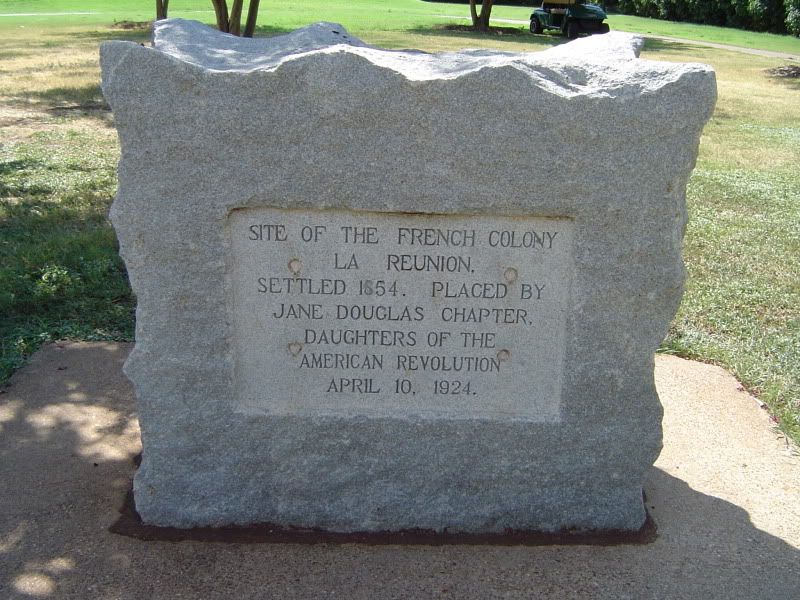
Granite DAR memorial at the Stevens Park golf course, marking the La Reunion site
The DAR memorial is a lovely tribute, but obviously not part of the original colony. For that, travel over to L.G. Pinkston High School at 3345 Fish Trap Road in Dallas and face northwest from the school. You'll be looking at a housing development, and right next to it there is a semi-neglected cemetery that was once known as Fish Trap Cemetery, but a historical marker within the chainlink fence surrounding the cemetery proclaims this the burial site for some of the La Reunion colonists:
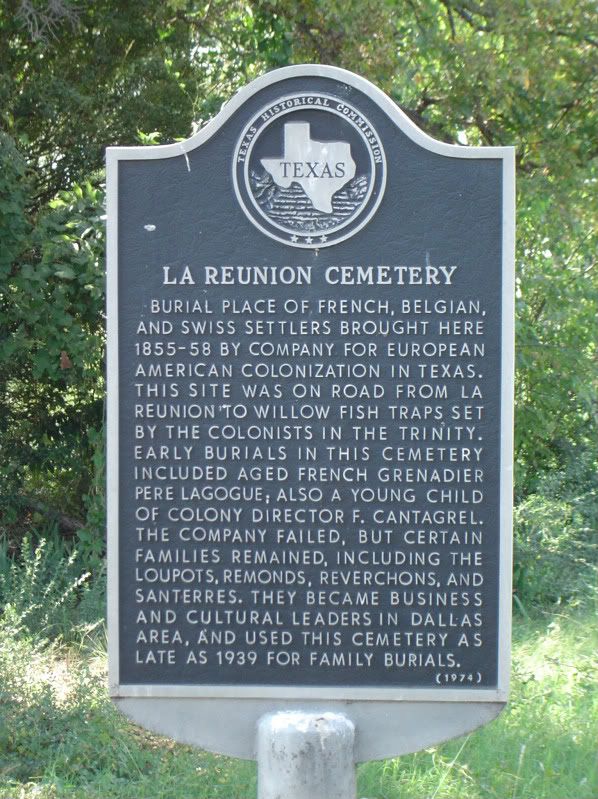
Historical marker for La Reunion Cemetery on Fish Trap Road in Dallas
According to a Dallas Morning News article on La Reunion Cemetery, there has been considerable difficulty finding which agency is responsible for the cemetery's upkeep. Some determined volunteers are doing what they can to tend to the cemetery, and once in a while, some enterprising ghost town chaser finds his way into the cemetery as well. Here are some of the graves at the site:

Tombstone for botanist Julien Reverchon and his wife Marie, both La Reunion colonists; Reverchon Park in Dallas is named in Julien's honor
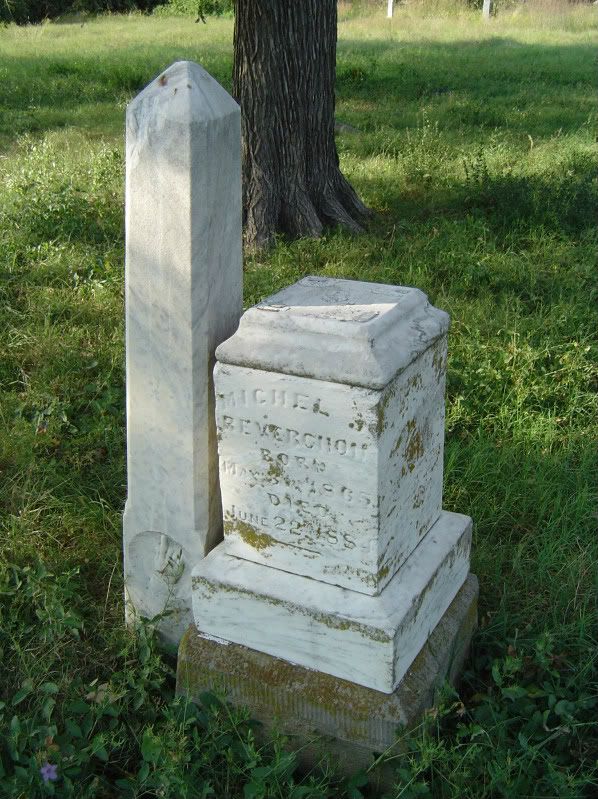
Broken grave marker for Michel Reverchon, son of Julien and Marie Reverchon
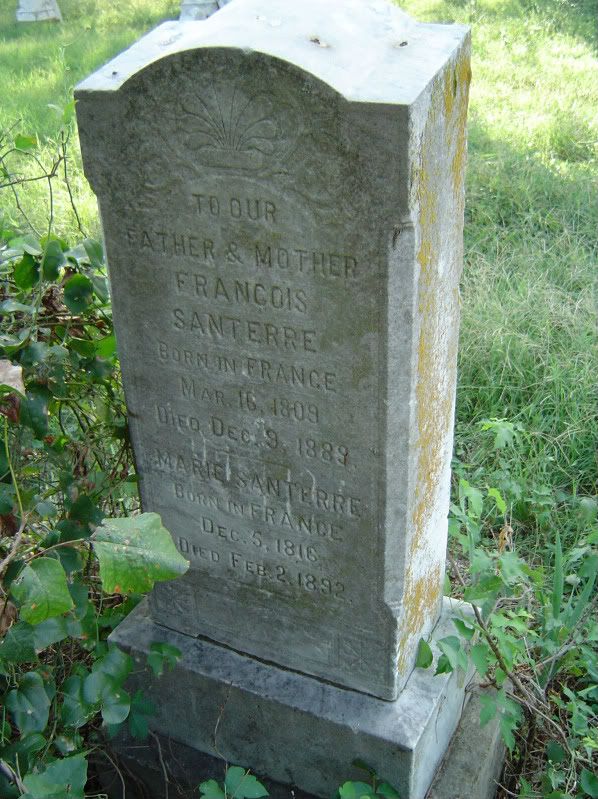
Francois Santerre, one of the most prominent La Reunion colonists, is buried here with his wife, Marie
Not everyone buried at La Reunion Cemetery, however, is a colonist or one of their descendants:
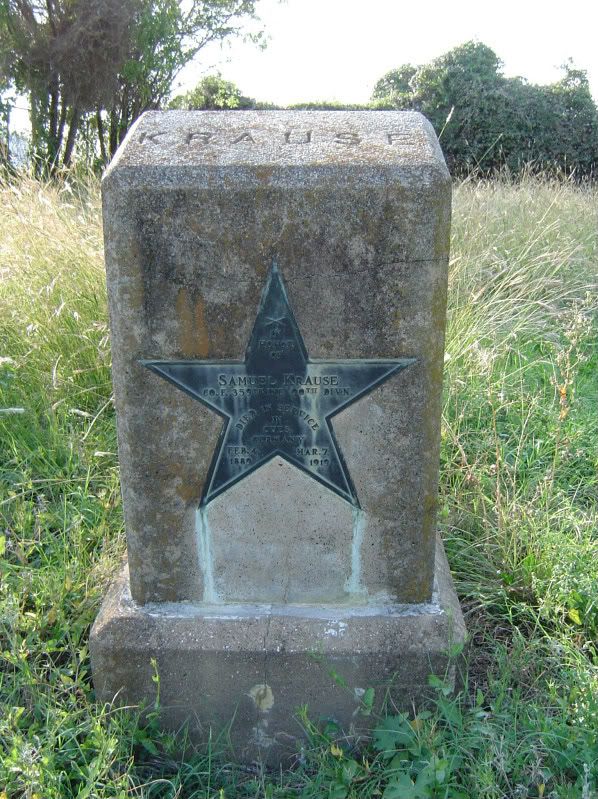
Grave of Samuel Krause, an uncle of Bonnie Parker; Bonnie herself was once interred here before being moved to Crown Hill Cemetery
But what of the ghost town itself? Other than the cemetery, does anything from La Reunion still survive? I'm going to let you in on a little secret:
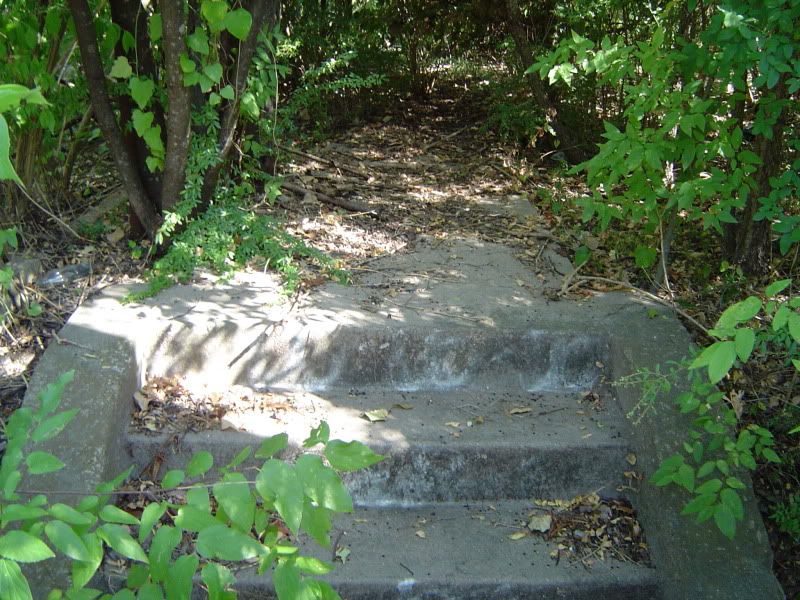
Front steps leading to the remains of the last remaining La Reunion house
Past these steps, on a sidewalk that is covered in dirt and choked with thick vegetation, there once stood a La Reunion colony house that survived all of its neighbors until it collapsed sometime in the 1930s. Even so, something still remains at the old homestead:

Small brick tower, part of the last La Reunion house
Where exactly are the remains of this ghost town house located? The precise location was known to a few schoolchildren in the area who would play there after school; supposedly there are a few more of these sites hiding throughout La Reunion. One of the children who knew of these ruins finally started spreading the word, and eventually the story reached me by means of the Internet, so I travelled to the La Reunion site and did a little exploring of my own until I found this. So I don't feel right just giving up the location, since a handful of Dallasites have made this their little secret. If you wish to find these ruins on your own, I offer this advice: Study the layout and history of La Reunion, drive and hike through the site of the old French colony, and keep your eyes open at all times.
One of these days, however, these last remnants of La Reunion may be swept away. The DAR memorial and the cemetery are safe, but there's a lot of money pouring into this area of Dallas, and with that money comes plans to redevelop the whole neighborhood. When that happens, the ghost town of La Reunion - which managed to survive all of its rivals for all these years - may be eradicated once and for all. So by all means, please go and explore this novel little corner of forgotten Texas history while you have the chance.
Happy Thanksgiving, everybody!
What a let down. Here I am working on a Google Map of Utopias and trying to nail down where near the Fishtrap Cemetery is La Reunion is and you tease me by giving all these clues but provide no answer. So, I gather from your clues, that it is all the land from just south of route 30 up to Trinity River. That is close enough for me.
ReplyDeleteCheck out my other maps at MyReadingMapped (http://myreadingmapped.blogspot.com/)and you can check out my progress on Utopia at https://maps.google.com/maps?ll=32.759227,-96.856888&spn=0.01,0.01&t=m&q=32.759227,-96.856888
Nice start on the map, but I'd like to add that the La Reunion Colony was over 2000 acres and went as far west as Cockrell Hill Rd and both sides of I-30. There is a 1986 Thesis by Thelma Irene Sandell detailing the facts of the La Reunion Colony you might be interested in reading. Very informative!
DeleteMy great great grandmother and her family, as well as my great, great, great, uncle (Julien Reverchon)and his family were among the settlers of what was once known as "Frenchtown". I would love to find the spot you, so enigmatically, describe:)If you would be willing you give me any other hints, I would be much obliged! My email is: eboisseau@lloyd-ins.com.
ReplyDeleteMe too! Through the Girard line. My 2nd great grandfather Pierre Girard Jr and his brothers built the large rock herbarium for Julien Reverchon. This rock structure is located on the grounds of The Dallas Country Club located in Highland Park
DeleteAnother interesting fact, the land between Chalk Hill, Westmoreland, I30 and Davis was once land owned by the old Texas Portland Cement Plant. Within the land boundaries was Cement City. The plant closed, the town was abandoned and the whole area fenced off. My brothers, cousins and I went out there squeezing under fences in the 80s and explored all the ruins of the town, the plant and found the cemetery now behind the building at 4331 Communications drive. The place was truly creepy back then but now completely destroyed by the development around, I feel so ashamed I never went back to take pictures of the ruins.
ReplyDeleteRhe cemetery you speak of was at one point the Lacey Family Cemetery, before the workers of Cement City took it over and buried their people there.
DeleteThis cemetery is located within the P Lacy land abstract #776. P Lacy was in fact Philemon Lacey, my 3rd great grandfather.
https://www.wikitree.com/wiki/Lacey-490
DeleteLots of maps regarding the area in this profile.
Given the amount of development around there, don't you find it a bit irresponsible to keep these locations hidden? Sure, savor the cache of your private knowledge, but someone who was truly devoted to preserving this kind of history would make sure others knew so that it wouldn't be swept away unknowingly.
ReplyDeleteCheck around the blog archives; you'll find more about La Reunion, including a visit by Dallas police and a city council member to the site that I explored. The site is no longer being ignored.
ReplyDeleteThere are a lot of people in Dallas who don't know, and could care less if they did know, that their condos, offices, and golf courses are directly on top of graveyards and historic sites.
ReplyDeleteMy great great grandfather (Nicholas Farine), settled in La Reunion from Dole(Besancon), France. He was thier to grow/cultivate grapes. He is buried in Sowers Cemetery in Irving, Texas.
ReplyDeleteHello,
DeleteI am a French historian. I wrote an article about the FARINE family.
Nicolas was born in Dole (Jura, France) on April 17, 1823. He arrived in New Orleans in 1858 to join the Reunion phalansteria. (French Colony). In 1859, he joined the small farming community of Elm, located about twenty kilometers northwest of Dallas, of which he is considered one of the founders.
If you are interested, I can convey to you information about his French ascendants. (birth certificates, marriages, deaths) since the 18th century.
Looking forward to your reply cordially
It is possible to reach me directly at this email address : charly.conus@aliceadsl.fr
DeleteCordially
A plethora of information about this Cemetery, some the people burid there and the surrounding long gone and forgot La Reunion and Eagle Ford.
ReplyDeletehttps://www.wikitree.com/wiki/Category:La_Reunion_Cemetery%2C_Dallas_County%2C_Texas